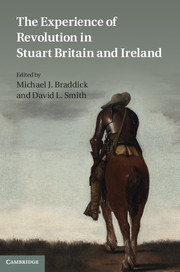Book contents
- Frontmatter
- Contents
- Notes on contributors
- Preface
- List of abbreviations
- JSM
- Introduction: John Morrill and the experience of revolution
- 1 The Scottish–English–Romish Book: the character of the Scottish Prayer Book of 1637
- 2 Popery in perfection? The experience of Catholicism: Henrietta Maria between private practice and public discourse
- 3 Sir Benjamin Rudyerd and England's ‘wars of religion’
- 4 Rhetoric and reality: images of Parliament as Great Council
- 5 Cathedrals and the British Revolution
- 6 History, liberty, reformation and the cause: Parliamentarian military and ideological escalation in 1643
- 7 Sacrilege and compromise: court divines and the king's conscience, 1642–1649
- 8 Law, liberty, and the English Civil War: John Lilburne's prison experience, the Levellers and freedom
- 9 On shaky ground: Quakers, Puritans, possession and high spirits
- 10 James Harrington's prescription for healing and settling
- 11 ‘The Great Trappaner of England’: Thomas Violet, Jews and crypto-Jews during the English Revolution and at the Restoration
- 12 The Cromwellian legacy of William Penn
- 13 Irish bishops, their biographers and the experience of revolution, 1656–1686
- 14 Religion and civil society: the place of the English Revolution in the development of political thought
- Bibliography of the major writings of John Morrill, 1967–2009
- Index
7 - Sacrilege and compromise: court divines and the king's conscience, 1642–1649
Published online by Cambridge University Press: 05 August 2011
- Frontmatter
- Contents
- Notes on contributors
- Preface
- List of abbreviations
- JSM
- Introduction: John Morrill and the experience of revolution
- 1 The Scottish–English–Romish Book: the character of the Scottish Prayer Book of 1637
- 2 Popery in perfection? The experience of Catholicism: Henrietta Maria between private practice and public discourse
- 3 Sir Benjamin Rudyerd and England's ‘wars of religion’
- 4 Rhetoric and reality: images of Parliament as Great Council
- 5 Cathedrals and the British Revolution
- 6 History, liberty, reformation and the cause: Parliamentarian military and ideological escalation in 1643
- 7 Sacrilege and compromise: court divines and the king's conscience, 1642–1649
- 8 Law, liberty, and the English Civil War: John Lilburne's prison experience, the Levellers and freedom
- 9 On shaky ground: Quakers, Puritans, possession and high spirits
- 10 James Harrington's prescription for healing and settling
- 11 ‘The Great Trappaner of England’: Thomas Violet, Jews and crypto-Jews during the English Revolution and at the Restoration
- 12 The Cromwellian legacy of William Penn
- 13 Irish bishops, their biographers and the experience of revolution, 1656–1686
- 14 Religion and civil society: the place of the English Revolution in the development of political thought
- Bibliography of the major writings of John Morrill, 1967–2009
- Index
Summary
If historians are agreed in seeing religion as having been crucial to the politics of the 1640s, then they have tended to see the clergymen involved as being exclusively Parliamentarian ones. By contrast, the Royalist clergy in the 1640s tend to be depicted as passive sufferers at best, meekly retiring from the political stage, humbly providing spiritual comfort on scaffolds or in country houses. Rather than the outspoken and politically meddlesome Laudians of the 1630s, the Royalist clergy seem to be reduced to a meek pastoral role appropriate to those who have been politically defeated. This impression of a politically inactive clergy is understandable. After all, Charles in the 1640s had no clerical adviser remotely equivalent to William Laud in the 1630s and after May 1641 the king had no clerical privy councillor at all – a situation not seen since the sixteenth century. The absence of clerical voices was encapsulated in early 1643, when the king arrived at a Privy Council meeting ready to put the case for jure divino episcopacy in response to a Scottish paper, but after heated opposition was persuaded not to do so. Nevertheless, as we shall see, Royalist divines did not disappear from the scene, meekly accepting the dismantling of the established church. They preached, wrote, published and argued over the changes, constructing vigorous new defences of the existing church, and deploying a biblical rhetoric and outspoken providentialism that could match or even exceed that of Parliamentarian ministers.
- Type
- Chapter
- Information
- The Experience of Revolution in Stuart Britain and Ireland , pp. 135 - 153Publisher: Cambridge University PressPrint publication year: 2011



